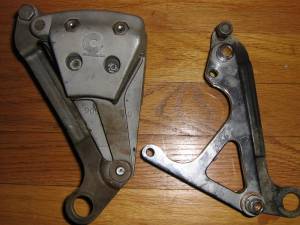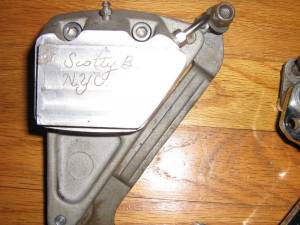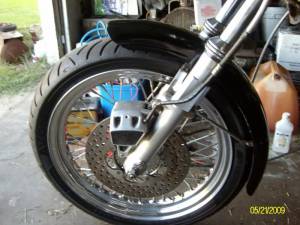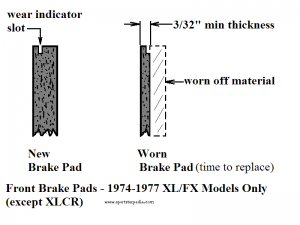Table of Contents
This is an old revision of the document!
IH: Wheels, Brakes & Tires
Brake System
See also Bleeding the Brake Lines In the REF section of the Sportsterpedia.
Drum Braking System
Front
Rear
Sub-Documents
Disc Braking System
Brake Fluid
Front
Front Master Cylinder
Rear
Rear Master Cylinder
Cleaning The Master Cylinder
- For use with DOT 5 brake fluid: Always clean brake system rubber parts by washing in denatured alcohol or DOT 5 brake fluid. Do not use mineral base cleaning solvents such as gasoline or paint thinner. These cause deterioration of non-metallic parts which would continue to deteriorate after assembly, possibly resulting in component failure. 1)
Rear Brake Clevis Rod
1980 and up:
- If the motorcycle should fall on it's right side or the muffler and bracket should hit the curb, the brake stop bracket could be inadvertently bent. This could then allow the brake pedal to travel past it's stop and could result in the distorting or bending of the clevis rod end (42445-80). Although the bend in the clevis rod end will not adversely affect the brake function, it could allow increased brake pedal free play. This condition would cause the brake pedal to travel further when applying the brake. 2)
- Inspection:
- Inspect brake stop bracket (welded to muffler) for the correct bend periodically.
- The bracket should form a 90° angle out from the muffler. If it is bent in either direction, tap it with a ball peen hammer to straighten it.
- Check the rear brake pedal adjustment. Work the rear brake pedal back and forth by hand to determine the amount of free play before the pushrod contacts the piston in the master cylinder. Free play measured at the pushrod should be app. 1/16“.
- Correction:
- If free play is excessive, inspect the clevis rod end (42445-80) for signs of distortion. If it is bent at the end, replace it.
- If free play is incorrect, loosen the jamnut and turn the adjusting screw in (clockwise) to increase free play, or out (counterclockwise) to decrease free play.
- When proper free play is achieved , apply Harley Davidson Lock 'N Seal (99625-77) to the threads and then tighten the jamnut to 12-15 ft-lbs. while holding the screw in position.
- When properly adjusted, the brake pedal should be parallel to the ground when bottomed against brake pedal stop.
Rear Brake Pedal Stop
* . . . Fabricating a Brake Pedal Stop
Calipers
Caliper ID and Applications
Front Caliper
- Banana
- 1973 XL, FX Models
- 1972-1984 FL Models
- Clebrake
- 1974-1977 XL, FX (single disc)
- Large Kelsey Hayes
- 1980-1983 FLT, FLHT
- Small Kelsey-Hayes
- 1977-1979 FXS
- 1978-1983 FX, XL
- Semi Torque Free Kelsey Hayes
- 1983-1985 XR1000
- 1984-up All models except FLH
- 1985 All models
Rear Caliper
- Banana
- 1973-1982 FX
- 1973-1983 FXE
- 1973-1980 FL
- Large Kelsey Hayes
- 1977-1978 XLCR
- 1979-1981 XL
- Dual Piston Kelsey Hayes
- 1981-1984 FL
- 1980-1985 FLT, FLHT
- Single Piston Kelsey Hayes
- 86-up FLT, FLHT, 87 1/2-up all BT models
- Lucas Girling
- 1982-E1987 XL,FXR
- 1983-1986 FXWG
- 1984-1985 FXE, FXSB
- 1984-E1987 FXST
- 1983-1984 and 1987 FLHS
Clebrake: (pie slice caliper)
Brake Disc and Pads
From HD Teschnical Service Bulletin M-712 dated June 16, 1977:
Disc brake friction material can be classified as organic, semi-metallic, or metallic.
Organic material will outwear an equal section of metallic material under normal operating conditions.
An organic pad will also reduce heat transfer between the brake disc and brake fluid in the caliper.
It is also less harsh on the disc and usually leaves the disc with a polished look.
This material has two disadvantages:
- The organic material will fade when high pad temperatures are developed.
- Wet stopping power is very poor when the material is thoroughly wet.
Metallic friction material increases it's efficiency as temperatures increase, and water has little effect on stopping performance.
Metallic linings, in normal service, have a shorter wear life than organic.
Semi-metallic have characteristics in between the organic and metallic.
Replace pads when the thickness of the friction material has worn down to 1/16” or less on all models except those specified in the paragraph below.
We suggest that you use only the recommended Harley-Davidson pads.
1974 thru 1977 XL, XLCH, XLT, FX, FXE, FXS models have a wear indicator slot in the front brake pad friction material.
Replace pads when the friction material has worn down to 3/32“ thickness as shown in the illustration.
Motorcycle brakes operate under high temperatures and can absorb far more horsepower than the engine produces. 7)
The discs do not need a polished appearance to maintain efficiency.
A disc with a slight amount of grooving similar to a phonograph record is normal with metallic brake pads and is acceptable if the surface is smooth.
The newer stainless brake discs may appear grooved, but if you run your fingernail over the surface you find there are no grooves.
Disc runout, on the motorcycle, should not exceed .015”. If the disc becomes warped or dished beyond this specification it should be replaced.
Brake pedal travel is increased with the wave washer type of piston retraction. Caution must be used when adjusting brake pedal travel.
If the required freeplay in the plunger is adjusted away, the expanding brake fluid cannot return to the reservoir and gradual energization of the brake may occur.
If there is any doubt concerning this freeplay or other proper operation of the master cylinder;
The master cylinder cap should be removed and the pedal depressed several times. A squirt of fluid each time will verify proper operation.
Disc and pad sets:
| Disc, Material | Pad |
| -73, mild steel | organic |
| -78, hard stainless | semi-iron, black |
| -79, very hard stainless | semi-iron, copper |
| -84, very hard stainless 11/12“ rotor | semi-iron, copper |
| -84A, 30 hole, anti symmetrical | semi-iron, copper |
| -94, softer stainless | semi-iron, gray |
Brake Fluid Leakage
Any fluid leakage in the brake system should be a signal for replacement of the particular component causing leakage.
On an older system, pay special attention to hoses, looking for cracked or cut surfaces which could develop leakage.




